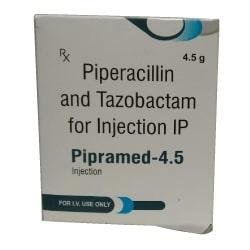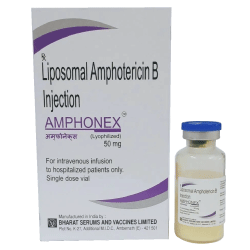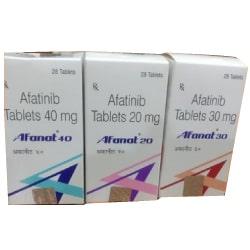Description
Piperacillin and Tazobactam vial comprises piperacillin, an antibacterial of the penicillin class, and tazobactam, an inhibitor of beta-lactamase. It’s prescribed for various infections in adults and children aged 2 months and older:
- Intra-abdominal infections
- Nosocomial pneumonia
- Skin and skin structure infections
- Female pelvic infections
- Community-acquired pneumonia
Dosage and Side Effects
For adult patients, Piperacillin and Tazobactam, a medication comprising piperacillin (a penicillin-class antibiotic) and tazobactam (an inhibitor of beta-lactamase), is used for various infections. Here are the recommended dosages for different conditions:
- Adult Patients with Other Indications (excluding Nosocomial Pneumonia): The standard daily dosage for adults is 3.375 grams administered every six hours, totaling 13.5 grams (12.0 grams of piperacillin and 1.5 grams of tazobactam).
- Adult Patients with Nosocomial Pneumonia: Initial treatment for patients with nosocomial pneumonia typically begins with Piperacillin and Tazobactam at a dosage of 4.5 grams given every six hours, along with an aminoglycoside, totaling 18.0 grams (16.0 grams of piperacillin and 2.0 grams of tazobactam).
- Adult Patients with Renal Impairment: Dosage adjustments are necessary for patients with kidney impairment (creatinine clearance ≤40 mL/min) and those undergoing dialysis. The adjustments depend on the degree of renal impairment.
- Pediatric Patients: The recommended dosage for pediatric patients aged 2 months and older, weighing up to 40 kg, and having normal kidney function varies based on age and condition. Dosages range from 80 to 112.5 mg/kg (of piperacillin and tazobactam) every 6 to 8 hours, depending on the age and condition.
The most commonly reported Piperacillin Tazobactam side effects include: diarrhea, constipation, headache, nausea and insomnia.
FAQ's
How is Piperacillin and Tazobactam combination medicine administered?
The combination drug Piperacillin & Tazobactam is given via intravenous infusion over 30 minutes. The dosage and frequency depend on the patient’s condition and age, as determined by a healthcare professional.
What infections does Piperacillin and Tazobactam treat in adults and children?
It’s used for various infections, including intra-abdominal infections, pneumonia, skin infections, female pelvic infections, and community-acquired pneumonia in adults. For children aged 2 months and older, it’s prescribed for specific infections as determined by a healthcare provider.
Can Piperacillin and Tazobactam cause severe reactions?
Yes, Piperacillin and Tazobactam can cause severe hypersensitivity reactions, skin issues like Stevens-Johnson syndrome, toxic epidermal necrolysis, and a rare condition called hemophagocytic lymphohistiocytosis (HLH). Regular blood tests are needed during long-term use to monitor for potential blood-related effects.
Is there a risk of nerve-related problems while administering Piperacillin and Tazobactam?
This combination drug, like other penicillins, might affect nerves and potentially cause seizures, especially in patients with kidney issues. Patients with kidney problems or seizure disorders need close monitoring for any signs of nerve issues.
Are there any specific warnings for critically ill patients?
Yes, Zos might affect kidney function in critically ill patients, potentially leading to kidney problems. Alternative treatment options might be considered for this population. If Piperacillin & Tazobactam remains the treatment choice, regular monitoring of kidney function during treatment is crucial. Additionally, any signs of diarrhea should be evaluated promptly.






